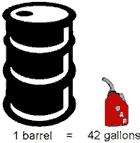Divide this number (of square feet) by the earlier number of gallons of oil
burned so far to conclude:
"We've burned 1 gallon of oil for every
≈38.187 or ≈38.2
ft2 of land"
(round to nearest 0.1 ft2)
Call this number A. Imagine dividing up all the land area on Earth
into parcels or portions each having this area. Thus we've burned one gallon of oil
for each such portion, if you can imagine dividing up all land on earth
-- not just the inhabited parts, but every
bit of land in the Sahara desert, every such bit of land in the
Amazon, every such bit of land in every city, town, field, hillside,
etc, into portions of this area, imagine a gallon of oil
consumed and no longer available, for each such portion.

